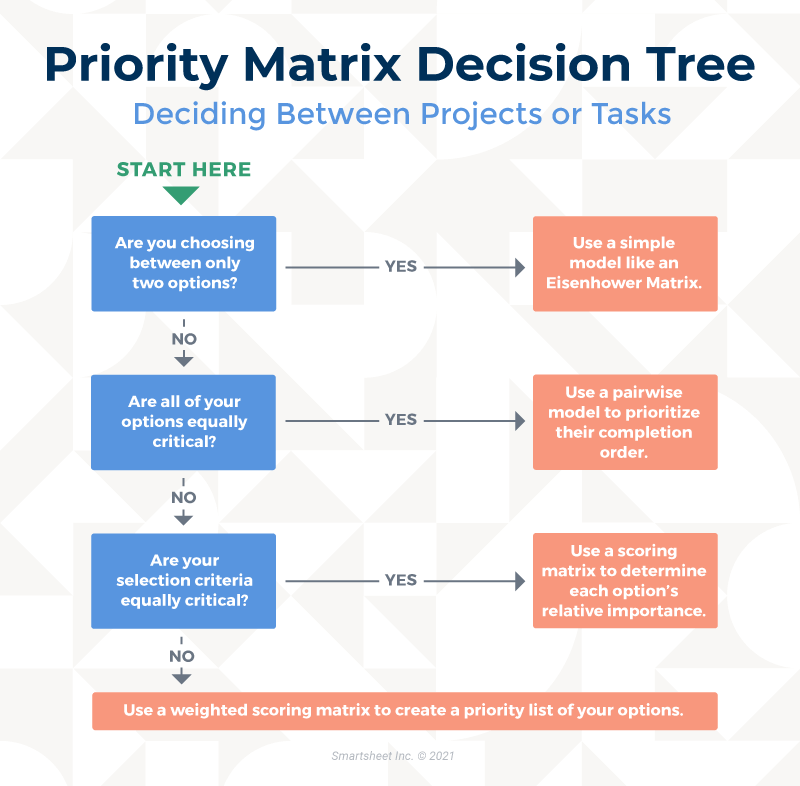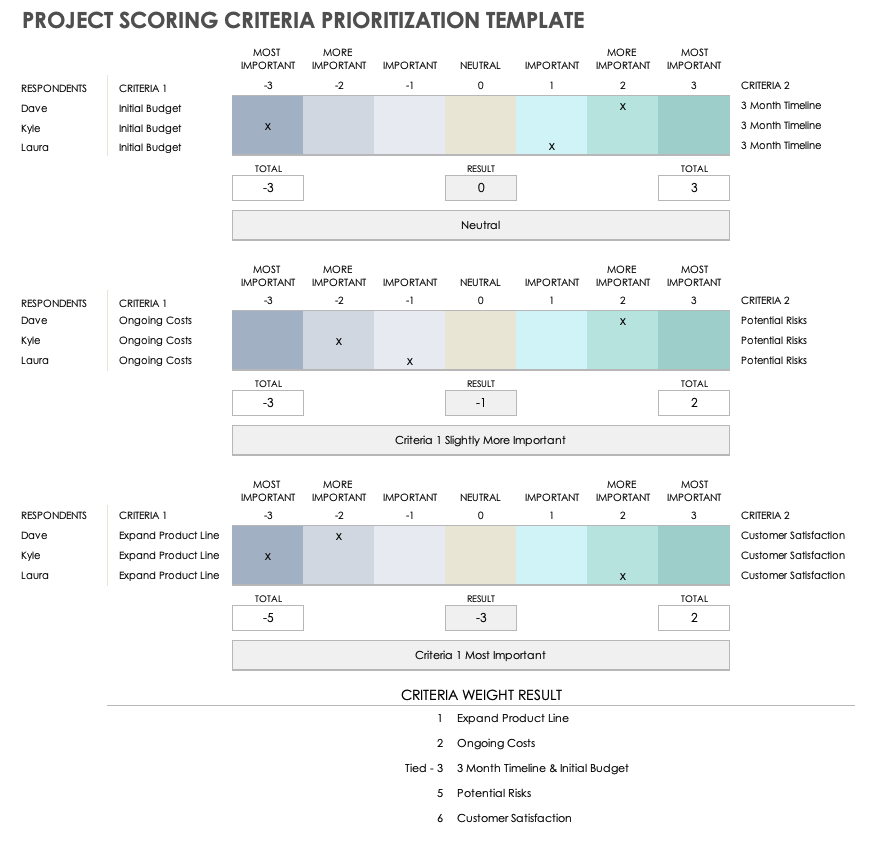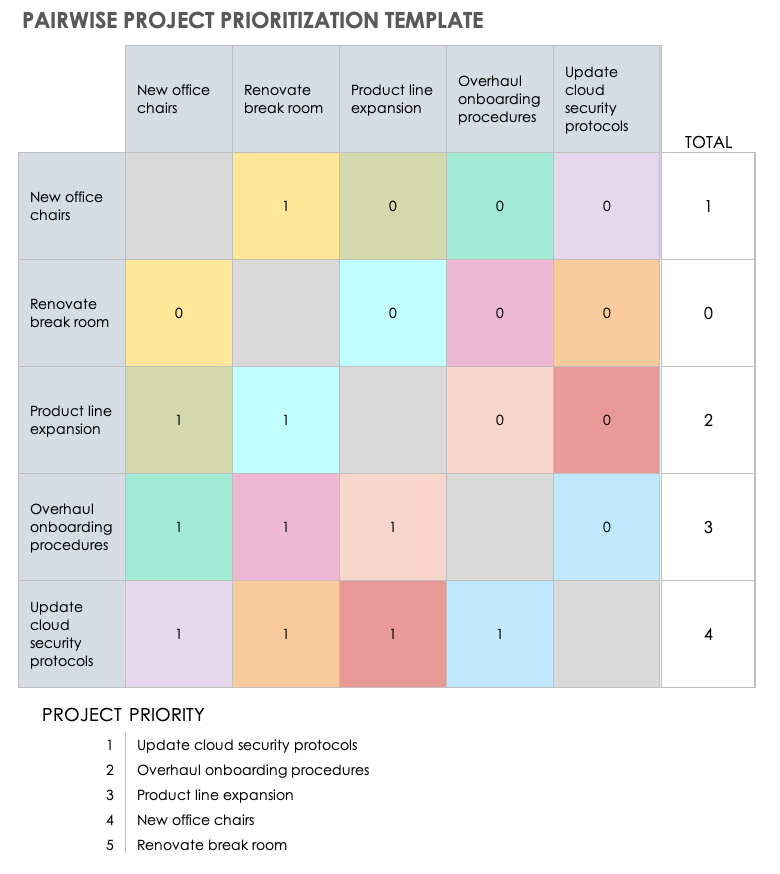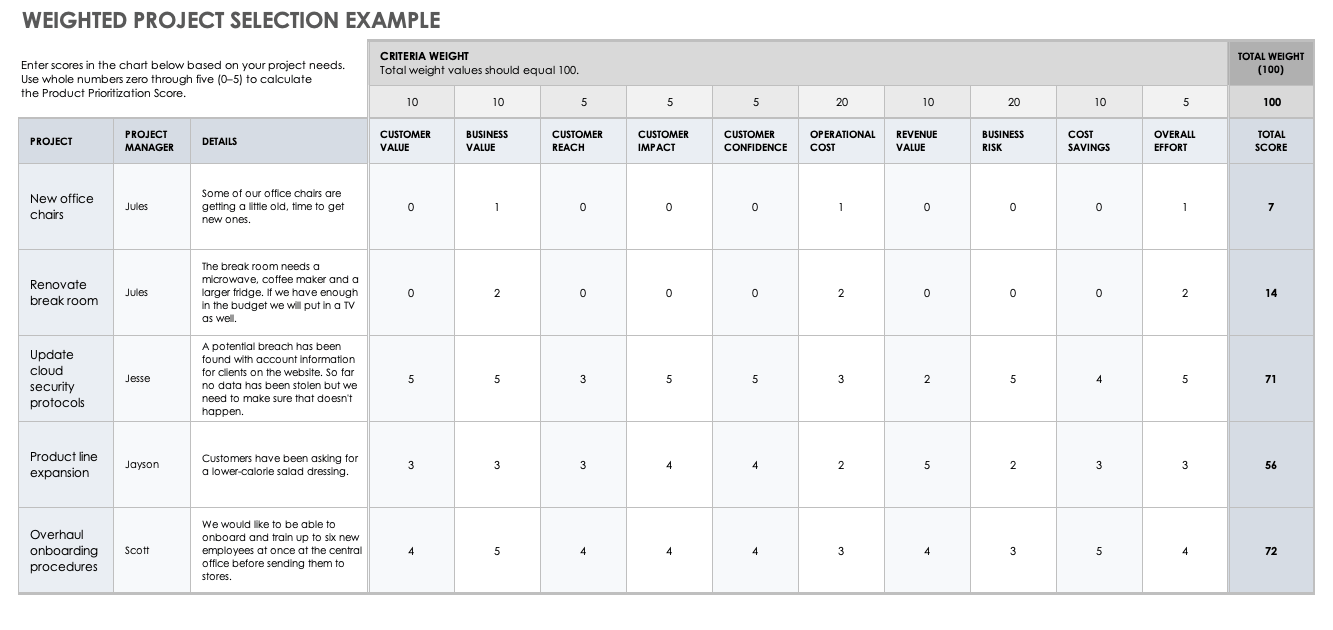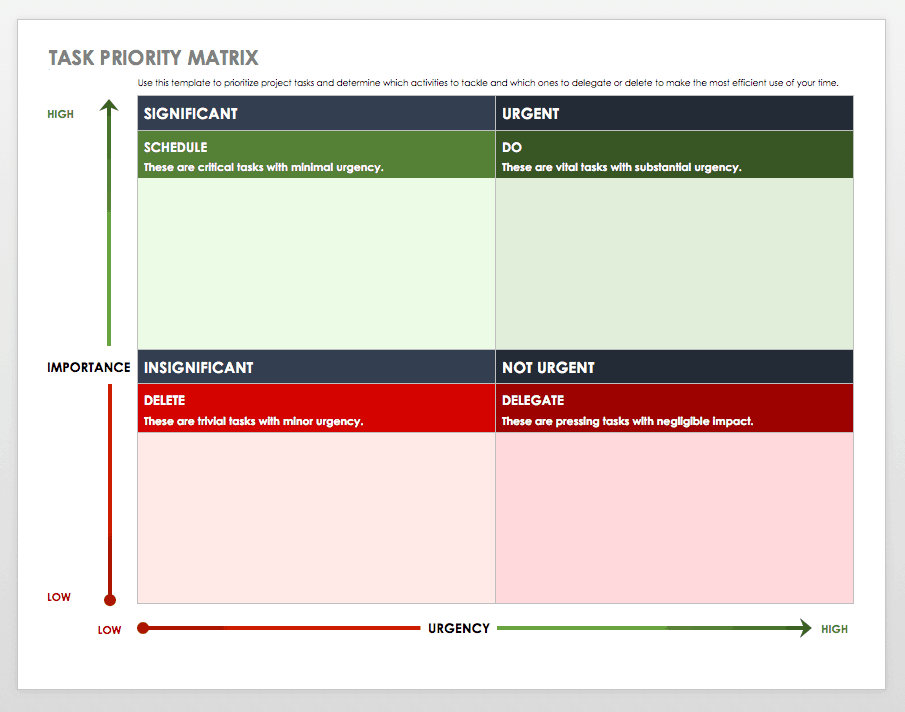What Is a Scoring Model in Project Management?
A scoring model is a tool you use to assign a comparative value to one or more projects or tasks. Scoring models allow governance teams to rank potential projects based on criteria such as risk level, cost, and potential financial returns.
The type and weight of criteria you choose will affect the results, so select the most critical factors for your organization and weigh them accordingly. While your company’s highest-level decision makers will ultimately choose which elements are most important, a project manager may facilitate this decision-making process by providing a survey or template to determine the most important factors for each respondent.
Principles of a Scoring Model
A scoring model should be simple and customizable, as well as produce results that are easy to understand. Scoring models provide insight into the overall value of a project, but since “value” is subjective, your model must reflect your organization’s values.
To keep your model simple, choose up to five of the most crucial project criteria for your organization. Once you select those criteria, consider the weight to give each of them; you will likely find some factors to be more significant than others. Lastly, no matter what type of scoring model you use, make sure that the model’s findings are easy to understand. Include a key the team can use to decode particular numbers or colors.
How to Use a Project Scoring Model
Project scoring models are a crucial tool for project selection. By creating a value-weighted list to compare potential projects, an organization can easily identify where it should allocate resources and identify its next course of action.
The ultimate goal of a scoring model is to prioritize a list of potential tasks or projects so that the team gains a better understanding of what to tackle and when. For instance, you may not have the resources to begin a high-priority project right away, but you may be able to complete a smaller, lower-priority task while waiting for those resources to become available.
You can use many types of models, but in general, a project that scores higher on your matrix is more important to the company. Model results are a great place to start, but you should also consider other less tangible factors, such as the potential interruption of other projects, interdepartmental timeline conflicts, or overall support for the project by the executive team.
To learn more about project selection, read our guide to project selection.
Scoring Criteria for Projects
The most common scoring criteria for projects include overall cost, time, and risk level. Projects are more complicated than simple tasks, so it is essential to create a holistic view of a venture when considering what criteria to include.
Keep things simple: Choose no more than five criteria when creating your model. Most scoring models use a scale numbering between 0-5 to represent the importance of each criteria to the organization.
The following are categories of criteria you may consider in your scoring model:
- Strategic Criteria: This category is generally the most intangible criteria, including elements such as overall business strategies, existing offerings or product lines, and market competitiveness. Strategic criteria can sometimes be difficult to quantify and may benefit from being measured along with financial considerations.
“At the end of the day, even if a project isn’t a financial success, it can still be good for the company. We always ask ourselves, ‘Is this project going to help make our company better?’ If yes, then it is a high priority,” says Jeremy Lyman, CEO and Co-founder of Birch Coffee. - Financial Criteria: You will typically display this figure as a range of costs for each project element. The final calculation will rank projects on overall budget needs. This figure is important but doesn’t tell the whole project story, so it is best to combine and compare it against other factors.
- Risk Factors: Factor risks as negative or reversed values. For example, if the goal of a scoring model is to determine the highest-scoring project, high-risk factors should detract from — not add to — that total. For risk factors, consider setting your low-risk value to 5 and your high-risk value to 0, so that high-risk factors do not add to your total score.
In general, you should weight a number of these criteria against one another to gain the best overall view into a complicated project. Your organization should come to an agreement about which factors are most important, and then weight and compare them accordingly. Consider administering a criteria selection survey to your governance board to help facilitate the selection and weighting process.
Project Scoring Criteria Prioritization Template
Download Project Scoring Criteria Prioritization Template
Microsoft Excel | Google Sheets
Use this project scoring criteria template to help choose the most important criteria for your organization. By recording the importance of each criteria to each decision maker, you can see the average value of each factor and distribute the weight for each in your scoring template accordingly.
Simplified Scoring Model in Project Management
Not every scoring model needs to reflect an entire project. You might need input on a few elements or a final ranking of potential projects. In such cases, consider a pairwise model or Eisenhower matrix.
A pairwise model is a simple grid that you can use to compare multiple projects or elements against each other, one at a time, to create a list in order of importance. An Eisenhower matrix is an even simpler two-by-two grid that you can use to compare tasks by urgency and importance.
Pairwise Project Prioritization Template
Download Pairwise Project Prioritization Template
Microsoft Excel | Google Sheets
Use this template to prioritize a list of tasks or projects against one another. Identify the most important element in each row with a ranking of 1; the template will tally your score and create a list of tasks in order of descending importance.
Weighted Scoring Model for Project Selection
A weighted scoring model creates a value-weighted numerical score for potential projects that is unique to the team. By carefully selecting your criteria and weighting them by importance, you can generate a score that helps you compare projects.
A weighted scoring model has the advantage of allowing a team to rank certain criteria as more important than others. Using this model, you can emphasize your specific needs while still factoring multiple variables into your selection process.
How to Build a Scoring Model in Project Management in Four Steps
There are four key steps to building scoring models for any kind of project. You need to have a goal in mind, determine your scoring criteria, assign your scores to those criteria, and compare the results of your aggregated data.
“Management teams need to craft a strategy, and then agree on criteria and weighting factors for prioritizing projects,” Randall Englund, Executive Consultant for Englund Project Management Consultancy. “Compare all projects against each other and repeat the process for each criterion. The objective is to come up with an ordered list of projects.”
- Identify the Scoring Criteria: Survey your governance board and determine the most relevant scoring criteria for your projects. If possible, limit your criteria to no more than five factors for ease of comparison.
- Weight the Scoring Criteria: Determine the weight of each criterion. They may all be equal weight, or you may find that some criteria are more essential than others. Consider using our scoring criteria selection template to prioritize your criteria and simplify this process.
- Record Your Input: Input your scores for each criterion and each project. Consider finding an average score for each element from the scores of your individual selection team members.
- Analyze the Results: Compare the resulting scores and determine if you need more information to reach a consensus. If two or more projects receive the same score, consider comparing specific budgets or timelines to narrow the choice further.
Scoring Model in Project Management Example Template
Download Weighted Project Selection Example Template
Microsoft Excel | Google Sheets
Use this template to weight and help you select your next projects. Easily input your own projects, weights, and criteria to customize this template to your needs. This matrix is designed with many sample criteria, but you can customize it to fit your needs.
How Do You Calculate Project Priority?
Generally, place a higher priority on projects that score higher in your scoring model than ones that score lower. Scoring models can help you identify which projects have the least inherent risk or the most opportunity for ROI, for example.
Stephen Light, CMO and Co-Owner of Nolah Sleep, shares his experience with priority matrices. “The best way to prioritize projects is to follow the task prioritization matrix, which is a visual guide that categorizes tasks into four different categories: urgent and important, urgent and not important, not urgent but important, not urgent and not important.
“It can be challenging to know which projects to prioritize because people don’t know how to segregate each project accordingly. With this method, it is easy to see the projects have a higher priority than others based on urgency and importance. The hierarchy of the tasks in the matrix is in descending order, so you should complete tasks that are at a higher level than those found below them.”
For more information about calculating project priority, check out our free priority matrix and project prioritization templates.
Project Prioritization Scoring Model
Project prioritization models compare a variety of factors, both tangible and intangible. A prioritization model might consider elements such as customer opinion, as well as concrete budgeting numbers. Weighted prioritization models are used to rank options to facilitate project selection.
Benefits of Scoring Models in Project Selection
There are many benefits to using scoring models in the project selection process. You have the ability to compare different types of projects and the ease of sharing those results. We’ve asked our experts to expand on these benefits below:
- Compare Different Project Types: Scoring models can help you compare and prioritize projects of different types or strategies against one another using more concrete criteria.
“Decide on a mix of projects consistent with business strategy, such as 50 percent platform projects, 20 percent derivative projects, 10 percent breakthrough projects, and 10 percent partnerships,” suggests Englund. “Note that these weights total only 90 percent — taking a lesson from financial portfolio management, diversify the set of projects by investing in some speculative projects as well.” - Less Biased Ranking: Scoring models help create a list of projects with fewer emotional decisions attached. Englund recommends that companies “[are] careful to balance the important projects rather than giving in to urgent but not so important demands.”
- Knowing When to Say No: Some projects sound great on the surface, but become less so when you compare your scoring criteria.
“It’s not just that you can be more selective — it’s that you need to be more selective. We need to work with companies that align with our brand, and we’ll only do projects with companies that we think do that,” Lyman says. - Easy to Compare at a Glance: Assigning a numerical score to each potential project aggregates diverse criteria into a simple, comparable form. By using the same criteria for every project on a list, you can ensure that those scores reflect each other in a way that you can reliably compare them.
- Organization and Ease of Sharing: Creating and using a scoring model is a great way to share information with a team. Rather than having a governance board share meeting notes, which may not tell a whole story, they can share a copy of their model, so that stakeholders can see both the process and the results.
Disadvantages of Scoring Models in Project Selection
No model is perfect, and there is no one-size-fits-all solution to project selection. Our experts share some difficulties with using scoring models, including their rigidity and the challenge of assigning numerical values to abstract concepts.
- Requires Sufficient Weighting of Criteria: It can be difficult to weight criteria against each other so that they truly reflect the values of a business. It is also possible that the importance of those criteria will change over the course of a project, which may be impossible to reflect in your model.
- Hard to Conceptualize Abstract Concepts: Some selection and prioritization criteria are more abstract than others. It can be difficult to assign a numerical value to customer satisfaction or community outreach, as opposed to budget numbers or timelines.
- Limited View of Scope: It is impossible to anticipate every facet of a new venture, and a scoring model can show you only so much. It is possible that you will overlook important criteria in the selection process, which may pose large hurdles down the line.
- Rigidity in Decision Making: Forms and templates often feel more rigid, which can be less attractive for creative or startup-style business management.
As Lyman says, “We’re a smaller organization that doesn’t have a lot of different people to create multiple teams to run multiple large projects. We find that models and software are sometimes too rigid and waste time. We get in a room, and we talk, and we just know intuitively what is more important.” - Doesn’t Always Reflect Reality: A model cannot always predict what will happen in a consumer market or a partnership with another business. “A lot of times I think people will take on a project with the promise that it will bring more business,” says Lyman. “We have put a lot of effort into things that ultimately didn’t pan out, and sometimes that was out of our hands completely. Sometimes you have to make these mistakes to learn. I hate saying no to a cool new project, but sometimes you have to. You learn from experience. As you learn as a brand, you have more flexibility to choose projects that will end up working for you.”
Get the Most Out of Scoring Models with Smartsheet for Project Management
From simple task management and project planning to complex resource and portfolio management, Smartsheet helps you improve collaboration and increase work velocity -- empowering you to get more done.
The Smartsheet platform makes it easy to plan, capture, manage, and report on work from anywhere, helping your team be more effective and get more done. Report on key metrics and get real-time visibility into work as it happens with roll-up reports, dashboards, and automated workflows built to keep your team connected and informed.
When teams have clarity into the work getting done, there’s no telling how much more they can accomplish in the same amount of time. Try Smartsheet for free, today.
